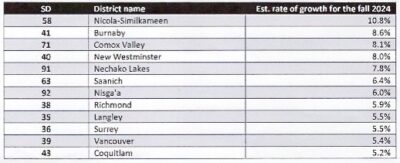Perspectives is an opportunity for Fellows and others to share their ideas in short, accessible essays. IPE/BC Fellows hold a range of views and interests relative to public education.
BC public school enrolment expected to surge in the fall of 2024
by John Malcolmson
August 29, 2024
Data recently released by BC’s Ministry of Education shows the province’s public school system anticipating a sizeable increase in student enrolment this fall.
The data is part of the Ministry’s Revenue and Expenditure Information system (https://www2.gov.bc.ca/gov/content/education-training/k-12/administration/resource-management/school-district-financial-reporting/revenue-expenditure-tables) and is released in distinct stages within each year as a means of reporting on district budgets. Because BC’s system of funding allocation is primarily enrolment-driven, the system offers a window of insight into the ebbs and flows of provincial student counts. Some historical information is also available to allow for cross-year comparisons.
The 2024 figures are estimates so they are subject to change. That being said, Ministry enrolment forecasts have historically been relatively accurate.
Last school year (2023/24) provincial enrolment dipped a small amount with about 1,400 fewer students in attendance compared with the previous year. However, this September, reports drawn from the school budgeting process show BC anticipating an additional 21,000 students for a net growth rate of 3.7%. If this projection pans out, this will be the first time BC’s public schools have crested above the 600,000 FTE enrolment mark since 1999.
The chart below places this number in recent historical perspective.

At first glance, the two-decade period shows a system in enrolment decline for the first half and in enrolment rebound and growth for the second. Over the period leading up to this September, the annual rate of enrolment change has averaged +0.4 per cent.
In the coming school year, almost three-quarters of BC’s school districts – 44 in total – are expected to grow while the remaining 16 will likely contract. Of the latter, most are in northern coastal or interior locations where school enrolments track population migration triggered by changes in local economic conditions.
The larger “growth cohort” shows some eye-popping rates of expected growth. The following table shows the top twelve growth districts, all of which are expected to expand more than five per cent.

Of the twelve, seven are within the Lower Mainland region and most are in suburban areas. Two are south/mid-Island while the remainder are located elsewhere. What is truly fascinating is that eight of the above 12 districts experienced enrolment loss last year! There is no immediate explanation for how or why the enrolment picture is expected to change so drastically for this group in the coming fall.
Budgeting implications
Enrolment change has significant implications for school district budgeting. Recent commentary by the Institute for Public Education / BC has drawn attention to the fact that BC’s financial support for K-12 education has fallen significantly in recent times when measured in relation to the key variable of provincial economic growth. As a result, and despite annual reported increases in nominal funding, school districts in this province face an ongoing reality of financial austerity. (See IPE’s recent letter to Premier Eby on this subject https://instituteforpubliceducation.org/wp-content/uploads/2024/07/June-25-letter-to-Premeir.pdf)
Changes in enrollment inject a wild card variable into the triaging that austerity invariably produces. When enrollments are in decline, boards of education face a continual need to reallocate meagre budgetary resources in efforts to manage the inevitable reduction in service delivery while limiting the damage done to existing school programs, staff and those who rely on affected programs.

BC’s expected enrolment surge this fall offers a unique opportunity for governments to assess problems created by the declining level of funding priority given to K-12 public education. This could and should result in efforts to institute a more robust system of funding support able to support districts, staff and students as they negotiate changes produced by a growth surge that could become a lasting fixture.
John D. Malcolmson, Ph.D, is an IPE/BC board member and a consulting sociologist providing research advice to unions on matters relating to compensation.


